Cold-blooded sea creatures seeking refuge from warming ocean waters may find themselves at increasing risk of deadly cold shocks due to changes in ocean currents, new research warns.
Climate change is pushing species to higher latitudes in an attempt to stay within their range of comfortable temperatures, but this migration can come with unforeseen consequences.
The new study, published in Nature, documents a mass mortality event in March 2021 that saw at least 260 dead sea creatures wash up on the shores of South Africa.
Using satellite data, ocean observations and data on the movements of bull sharks, the researchers link the event to a sudden influx of cold water coming up from the deeper ocean.
They also show that such events have been increasing in frequency over the past three decades and forecast that this trend may continue into the future as the world continues to warm.
One of the study authors tells Carbon Brief that “we predict this is going to become a more regular phenomenon and could impact a lot of different species”.
Marine migration
As the Earth warms, many species that are able to do so are migrating to higher latitudes, allowing them to maintain their place within their “thermal niche” – the set of temperatures at which they can comfortably survive.
Nowhere is this effect more pronounced than in the global oceans, where there are fewer barriers to migration than there are on land. On average, highly mobile marine species have been moving polewards by nearly 60km per decade since the 1950s, according to the latest report on climate impacts from the Intergovernmental Panel on Climate Change (IPCC).
But this migration comes with its own risks.
These shifting ranges due to climate change can introduce species to new, unfamiliar stressors – such as shipping lanes or fisheries, says Dr Natalie Posdaljian, a bioacoustician at Scripps Institution of Oceanography in La Jolla, California, who was not involved in the study.
One of these risks is what the researchers describe as a temperature “bait and switch” – where creatures seeking warmer waters can instead be trapped by a sudden cold event. Posdaljian tells Carbon Brief that the new study is the first time that she’s seen evidence of this hazard.
Mass mortality
On 2 March 2021, dead sea creatures started washing up on the south-eastern shores of South Africa between Port Elizabeth and East London. In all, more than 250 individual organisms and 82 separate species were found, including large, migratory species such as manta rays and bull sharks.
In deducing what had happened, the team of researchers examined the temperature data in the days leading up to the event. Using satellite and other observational data, they found that the temperature of the surrounding ocean had dropped by up to 9.2C in less than 24 hours.
The cold event persisted for seven days and had “severe physiological consequences” for the marine organisms there, including hypothermia, malfunction and death, the paper says.
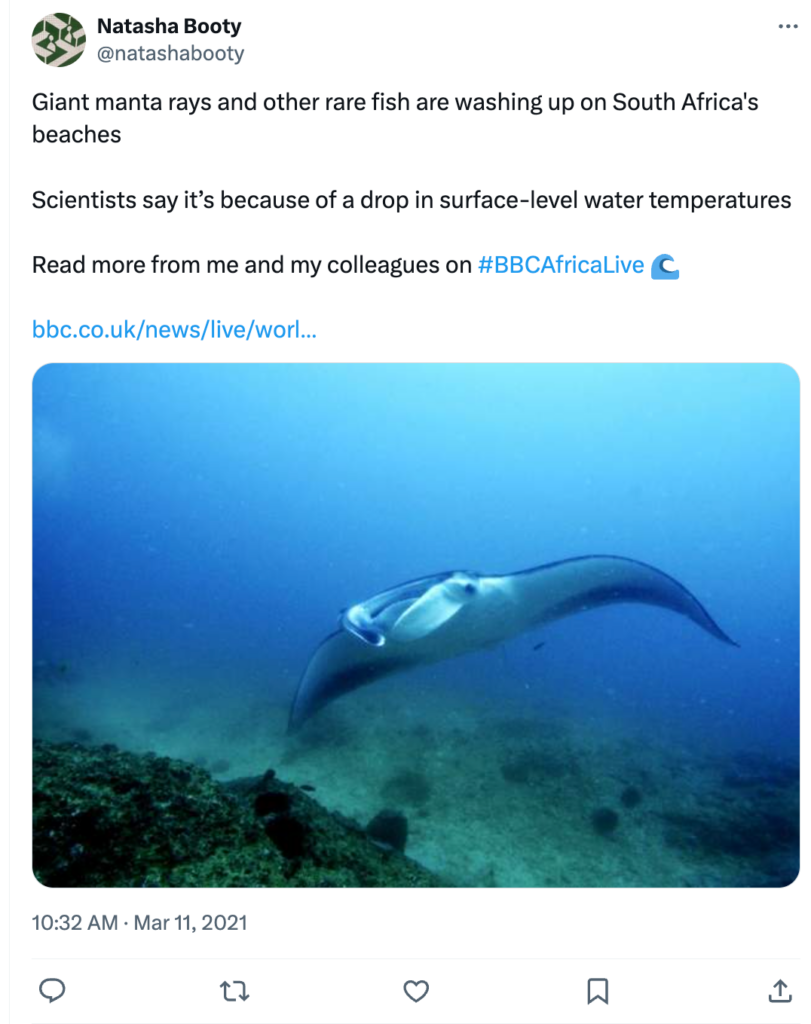
Similar cold shocks have previously occurred in south-eastern South Africa, dating back to at least 1989 and affecting a wide array of creatures, according to the study. But this instance was “probably the biggest cold-water shock [mass mortality event]” ever recorded, Dr Ryan Daly, a marine scientist at the Oceanographic Research Institute in Durban, South Africa, tells Carbon Brief. Daly is one of the authors of the new study.
The influx of cold water was due to a process called “upwelling”, which carries cold, nutrient-rich water from the ocean depths to its surface.
The study identifies three factors that make rapid upwelling events likely to happen: strong currents interacting with the continental shelf, strong winds blowing from the east to the west and meanders in the current. Such winds occur predominantly during the southern hemisphere’s summer, between October and April. They often act as a harbinger of temperature drops occurring in the coming 0-72 hours, the study notes.
All three of these factors are characteristic of both the south-eastern coast of South Africa and the eastern coast of Australia, where strong currents known as the Agulhas and the East Australian Current, respectively, run up against the continental shelf.
‘Trapped’
Dr Camrin Braun, an ocean ecologist at the Woods Hole Oceanographic Institution in Massachusetts, finds it surprising that even large, migratory species such as rays and bull sharks were killed by the cold snap. Braun, who was not involved in the new research, tells Carbon Brief that these animals “can move really far and really fast”.
Daly says that this surprised the research team as well. But it’s possible, he says, that the onset of the cold temperatures was quick enough and large enough that the animals got “trapped” instead of being able to escape.
To underscore this, the researchers use data on bull shark movements and ocean temperatures from tags attached to sharks before, during and after the event.
They find that the sharks consistently demonstrate “attempted avoidance” of lower temperatures – moving closer to the surface while swimming through upwelling areas and only travelling at deeper depths once they reach warmer waters.
The team also observe one shark taking up residence in a sheltered bay during one upwelling event to escape the cold waters. The researchers write that these actions “probably represent behavioural strategies to avoid/survive intense temperature declines”.
On its own, the shark-movement data is “kind of limited” and does not “make a very convincing case”, Braun says. But combining it with other data “really up[s] the ante on the importance” of the research, he adds.
Climate patterns
The researchers also look at several decades’ worth of sea surface temperature and wind data to understand whether these upwelling events are changing in frequency or intensity.
They identify clear increasing trends in the proportion of winds that favour upwelling events across three sites in South Africa. (Previous research has shown a similar increase in such winds in south-eastern Australia.)
Then, for the three South African sites and three Australian sites, they compare temperature data from three locations: “inshore”, defined as between 0-15km from the shore, “midshelf”, which is 15-30km from the shore and “offshore” – located within the warm “core” of the current. The inshore and midshelf locations fall within the upwelling zone, but the offshore ones do not.
If, as they hypothesised, upwelling events were becoming more frequent, the number of cold events inshore would increase over time, while the number of such events offshore would stay the same. Similarly, an upwards trend in the intensity of cold snaps would be revealed in the inshore and midshelf, but not the offshore, data.
The chart below shows that the proportion of upwelling-favourable winds (top left) at three sites in South Africa has been steadily increasing since the “upwelling season” – the period of upwelling-favourable winds stretching from October to April – of 1988-89.
The other three charts show increasing trends in the number of cold events (top right), the average intensity of cold events (bottom left) and the average rate of onset of such cold events (bottom right) for a single site, Port Alfred, over the same period. All three characteristics increase over time for the inshore (blue) and midshelf (pink) locations, but not the offshore (green) one, supporting the idea that the cold snaps are linked to upwelling.
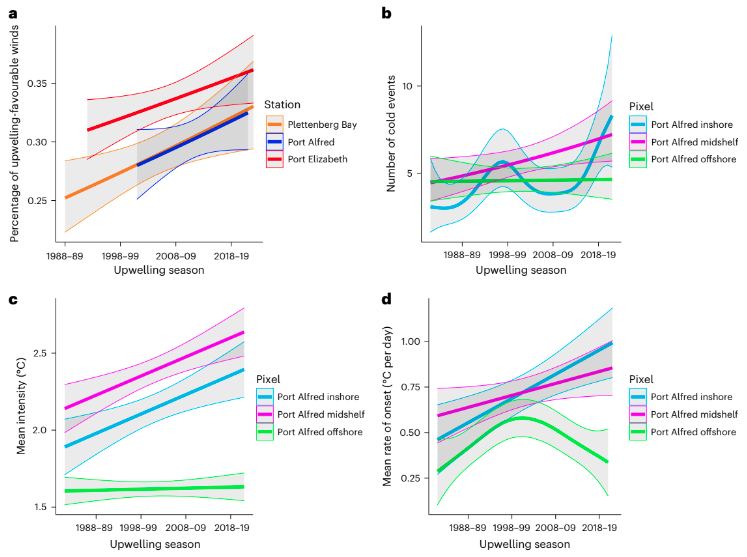
These increases persist over long enough time periods, the authors argue, to be clear evidence of long-term trends, rather than natural variation. Furthermore, the study points to previous research – dating back more than 30 years – that shows evidence of climate change increasing upwelling intensity due in part to increasingly strong winds driven by the land warming faster than the ocean.
This trend analysis is one of the most valuable contributions of the new study, Posdaljian says. She tells Carbon Brief:
“It’s often hard to be able to have that kind of concrete evidence about how something could be increasing in intensity or frequency over time.”
The idea that climate change could lead to an increase in cold snaps may seem counterintuitive. But those increased temperatures “mean more energy in the climate [system] too”, Daly says. He explains:
“This wind-driven upwelling, linked to climate change, is essentially an extreme event – just like we might have more flooding and stronger cyclones and hurricanes.
“If you think about equivalent on land, that might be fires being fuelled by more intense wind. It takes an existing natural phenomenon and basically supercharges that to become [more] intense.”
He adds:
“Going forward, we predict that this is going to become a more regular phenomenon and could impact a lot of different species.”
The researchers “did a really good job of creating this foundational understanding” of how such cold events could hit marine ecosystems in future, Posdaljian says.
Looking ahead, she adds that she would like to see more work focusing on projecting future trends in cold snaps and perhaps even being able to predict them. She tells Carbon Brief:
“A lot of these animals are not just dealing with one stressor from climate change…We can’t necessarily mitigate these [extreme events], but what we can do is maybe reduce the other stressors that we can control.”
jQuery(document).ready(function() {
jQuery(‘.block-related-articles-slider-block_b8f08245ed4649ee23116a4fece94aec .mh’).matchHeight({
byRow: false
});
});
The post Climate change ‘bait and switch’ threatens sharks and rays appeared first on Carbon Brief.










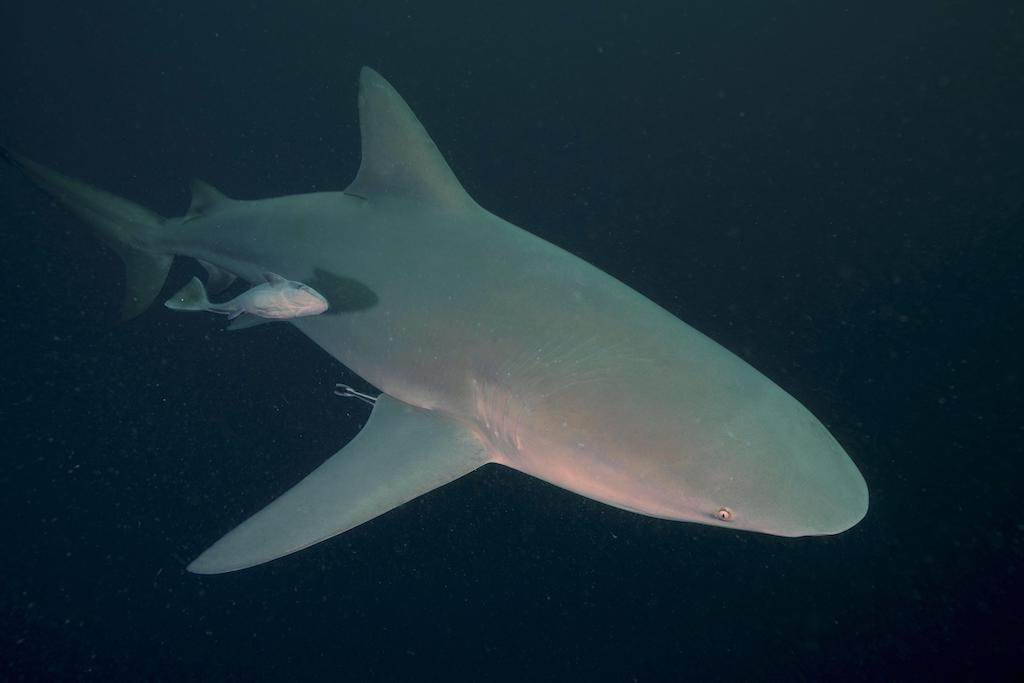
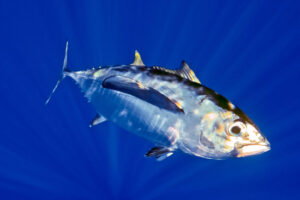
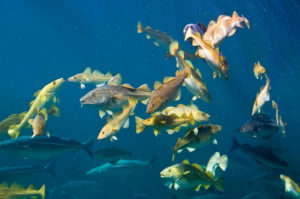
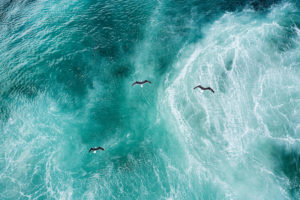
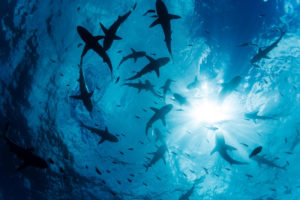






 (Updated 2025*)
(Updated 2025*)
Discussion about this post